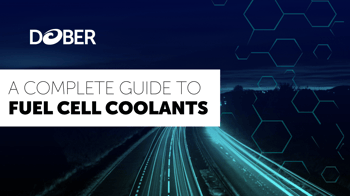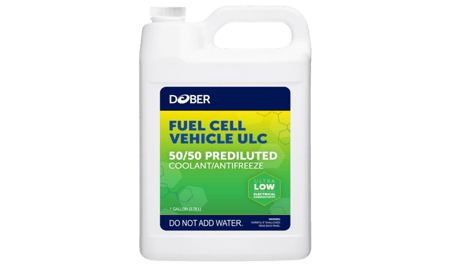Electrolyzers for hydrogen production are the most important energy-related device in the world in the coming years.
Why?
Because electrolyzers are producing the fuel of the future.
Hydrogen-powered technology still has a ways to go before it supplants existing modes of power (e.g., replacing diesel in the heavy-duty trucking industry). With that said, electrolyzers are a key piece of the viability narrative. Without fuel, fuel cell technology is just technology.
That reality was endorsed by funding in the 2022 Infrastructure Investment and Jobs Act, which included $8 billion toward the establishment of "regional clean hydrogen hubs" at strategic locations throughout the United States.
Powered by hydrogen, these innovative and cutting-edge developments transition from mere technology to real-world, practical applications at scale. However, just like fuel cell vehicles, electrolyzers also need a coolant to keep them running properly, which we will also delve into shortly.
To show just how far electrolyzer technology has come (and how much further it will likely go), let's first take a look back at where it came from.
The history of electrolysis dates back to the late 18th century when Italian physicist Luigi Galvani discovered the concept of "animal electricity," which later became known as bioelectromagnetism. In 1800, Alessandro Volta built the first electrical battery, which led to the development of the field of electrochemistry.
One of the earliest applications of electrolysis was the production of sodium and chlorine by the English chemist Humphry Davy in 1807. He used a battery to pass an electric current through molten sodium chloride (table salt), causing it to break down into its constituent elements. This process became known as electrolysis, a term derived from the Greek words "electro" meaning "electricity" and "lysis" meaning "breaking down."
In 1833, Michael Faraday formulated the laws of electrolysis, which describe the relationship between the amount of electricity passed through a solution and the amount of material produced at the electrodes.
In the early 20th century, the use of electrolysis became more widespread, particularly in the production of aluminum. In 1886, Charles Martin Hall and Paul Héroult independently developed a process for producing aluminum using electrolysis, which revolutionized the aluminum industry.
Today, electrolysis is used for a wide range of applications, including the production of metals, chemicals, and gases such as hydrogen and oxygen. It is also used for wastewater treatment, desalination, and in the production of various consumer products.
As mentioned, electrolysis is an important component of fuel cell technology, which generates electricity through the chemical reaction of hydrogen and oxygen.
Through the process of electrolysis — essentially, splitting water molecules into hydrogen and oxygen atoms — these devices provide the fuel that will go into a wide range of applications, including fuel cell vehicles.
When it comes to energy for the internal combustion engine, most people can visualize the source of the gas that goes into their car (maybe an on- or off-shore oil rigs come to mind).
But times are changing, meaning it's time to think about energy — and how we get it — in a new way.
Not only are times changing, but they're changing quickly.
According to a September 2022 report from the International Energy Agency, total installed electrolysis capacity had reached 242 MW in 2019. The IEA forecast that capacity to reach 5,517 MW in 2023.
"2021 saw significant growth in annual capacity additions, becoming the year with the largest deployment in the historical series: more than 200 MW of electrolysis capacity became operational, a threefold increase compared with the previous record year, and total installed capacity reached more than 500 MW, a nearly 70% increase compared with 2020," the IEA explained in the report.
Bottom line? There will be a need for hydrogen, and electrolyzers — whether alkaline, proton electrolyte membrane, solid oxide or some other form — will be needed to get the world through the energy transition.
There are several types of electrolyzers, each operating in different ways and under different conditions.
We'll review some of the most common types of electrolyzers below:
Alkaline electrolyzers
These are the currently the most common type of electrolyzer.
In these, hydroxide ions (OH¯) pass through from the anode side through the cathode side of the electrolyzer, thus leading to the generation of hydrogen.
As the Department of Energy notes, "liquid alkaline solution of sodium or potassium hydroxide as the electrolyte have been commercially available for many years."
Polymer electrolyte membrane (PEM) electrolyzers
Polymer electrolyte membrane (PEM) electrolyzers are a type of electrolysis cell that uses an acidic polymer membrane as the electrolyte. The process involves the splitting of water molecules into hydrogen and oxygen gases using an electrical current.
In a PEM electrolyzer, water is fed into the anode compartment of the cell, while a cathode compartment contains a catalyst, typically platinum. An external DC power source is used to supply the energy needed to split the water molecules into their constituent gases.
As the current flows through the cell, water molecules at the anode are oxidized to produce oxygen gas and positively charged hydrogen ions (protons). The protons migrate through the PEM to the cathode compartment, where they combine with electrons from the external circuit to form hydrogen gas.
Solid oxide electrolyzers
Meanwhile, solid oxide electrolyzers are not quite as far along in their R&D arc as the aforementioned alkaline and PEM options.
Solid oxide eletrolyzers operate at much higher temperatures. Whereas alkaline electrolyzers typically operate at below 100 degrees Celsius, solid oxide electrolyzers typically operate at around 700-800 degrees Celsius. This allows for more efficient electrochemical reactions and reduces the energy required to drive the process.
Solid oxide electrolyzers (SOE) are a type of electrolysis device that use a solid oxide material as the electrolyte instead of a liquid electrolyte.
The SOE consists of a ceramic electrolyte, which separates the anode and cathode compartments, and acts as an ion conductor for oxygen ions. When an electric current is applied, oxygen ions from the cathode are transported through the solid oxide electrolyte to the anode.
At the anode, the oxygen ions combine with electrons to form oxygen gas, which is then released into the environment. Simultaneously, hydrogen gas is produced at the cathode through the electrochemical reduction of water.
SOE can be integrated with renewable energy sources, such as wind and solar, to produce clean hydrogen fuel, making it a promising technology for energy storage and decarbonization efforts.
SOE has potential applications in various sectors, including transportation, industry, and power generation, and is being actively researched and developed for commercial use.
Electrolyzers represent a critical component of the world's green-energy journey and, more specifically, the development of hydrogen-powered applications (for example, heavy-duty vehicles).
Without them, those applications wouldn't have fuel.
Through the process of electrolysis, electrolyzers split water into hydrogen and oxygen atoms. The resulting hydrogen can then be stored for use in a number of applications, including fuel cell vehicles.
"Electrolyzers can range in size from small, appliance-size equipment that is well-suited for small-scale distributed hydrogen production to large-scale, central production facilities that could be tied directly to renewable or other non-greenhouse-gas-emitting forms of electricity production," the Department of Energy explains on its hydrogen production page.
Inside the electrolyzer, there are two electrodes, an anode and a cathode, which are placed in an electrolyte solution typically composed of water and an electrolyte such as potassium hydroxide. When an electric current is passed through the electrodes, the water molecules are split into hydrogen and oxygen gas.
At the anode, the water molecules lose electrons, producing oxygen gas and positively charged hydrogen ions (protons). Meanwhile, at the cathode, the electrons released from the anode combine with the hydrogen ions and form hydrogen gas.
The hydrogen and oxygen gases produced by the electrolyzer can be collected separately and used as a source of fuel for various applications, such as powering fuel cells or for industrial processes.
As mentioned earlier, the operation of electrolyzers requires cooling capacity aided by a dedicated electrolyzer coolant.
Elsewhere, we outlined why fuel cell coolants are different than coolants for internal combustion engine and even battery electric vehicles. Namely, fuel cell vehicles require significantly lower levels of electrical conductivity (less than 2 microsiemens per centimeter, as opposed to less than approximately 100 microsiemens per centimeter for battery electric vehicles).
Furthermore, fuel cells contain different materials than internal combustion engines, meaning they require coolant additive protection specific to those metals, plastics, etc. In a nutshell, the coolant must provide material compatibility so the materials in the applications do not corrode.
For these reasons, among others, you need to make sure your electrolyzer coolant has been tested and meets specifications (at right, you can see part of the Dober fuel cell testing lab). 
Just like fuel cells, electrolyzers need significant process cooling. In theory, an effective fuel cell coolant can also be used for electrolyzer applications. Like the fuel cell stack, the electrolyzer features an electrolyzer stack that Plug Power refers to colorfully as a "multi-decker sandwich."
As the National Renewable Energy Laboratory noted in a 2019 paper on manufacturing proton exchange membrane electrolyzers, "Manufacturing Cost Analysis for Proton Exchange Membrane Water Electrolyzers," (Mayyas et al), "PEM electrolyzer stacks have many similar parts as PEM fuel cell stacks and—include the CCM, a gas diffusion layer, and bipolar plates."
The main takeaway here is that, just like fuel cells, electrolyzers need an effective coolant to transfer excess heat out of the system and provide corrosion protection.
Hydrogen is shaping up to be the fuel of the future: electrolyzers will be the facilitator of that energy transition.
Furthermore, electrolyzer stacks have many similarities to fuel cell stacks. This means it is possible to use the same coolant — or slight variants of a baseline coolant formulation — for both applications.
The good news, then, is that those who have developed a fuel cell coolant already have a leg up when it comes to coolants for electrolyzers.
In addition, the U.S. government is expected to announce recipients of federal funding for the establishment of regional hydrogen production hubs this fall (fall 2023). That announcement will accelerate the pace of development in the space and encourage uptake of hydrogen-powered technologies. (You can sign up to receive updates from the Office of Clean Energy Demonstrations on the government's regional hydrogen hubs project.)
Currently, the infrastructure isn't there for mass use of hydrogen-powered applications (e.g., vehicles). However, between public and private investment, in addition to ongoing education about the benefits of green hydrogen, the demand for electrolyzers and electrolyzer coolants will only continue to grow in the years ahead.





